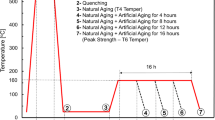Abstract
In this research, the possibility of applying forming limit diagrams to the formability and fracture prediction of clad metal sheets is examined. The forming limits of clad metal sheets with different thickness combinations (e.g., A1050 1.0, 1.5, 2.0 mm/C1100 1.0 mm) are investigated via forming limits test (punch stretching tests). The true stress–strain curves of Al/Cu clad metal sheets are obtained through tensile tests. Using the experimental forming limit diagrams and the stress–strain curves, the fracture prediction of clad metal sheets are simulated by finite element analysis. Moreover, deep drawing tests are carried out to compare the experimental with the numerical results. These results can verify the accuracy of finite element model. Finally, significant differences in formability are found, and comparisons of the fracture prediction of clad metals with different initial thickness ratios are analyzed both numerically and experimentally.
Similar content being viewed by others
References
Jung CG, Seung DY, Yang DY, Na SJ (2009) Development of a continuous fabrication system for a metallic sandwich plate with a three-dimensional truss core. Int J Adv Manuf Technol 45:352–361. doi:10.1007/s00170-009-1964-4
Tseng HC, Wu ZC, Hung C, Lee MH, Huang CC (2009) Investigation of optimum process parameters on the sheet hydroforming of titanium/aluminum clad metal for battery housing. 4th International Conference on Tube Hydroforming, September 6–9, Kaohsiung, Taiwan
Mahendran G, Balasubramanian V, Senthilvelan T (2009) Developing diffusion bonding windows for joining AZ31B magnesium and copper alloys. Int J Adv Manuf Technol 42:689–695. doi:10.1007/s00170-008-1645-8
Nowicke JrF Zavaliangos A, Rogers HC (2006) The effect of roll and clad sheet geometry on the necking instability during rolling of clad sheet metals. Int J Mech Sci 48:868–877. doi:10.1016/j.ijmecsci.2006.01.021
Özdemir N, Bilgin B (2009) Interfacial properties of diffusion bonded Ti-6Al-4V to AISI 304 stainless steel by inserting a Cu interlayer. Int J Adv Manuf Technol 35:814–820. doi:10.1007/s00170-008-1493-6
Masahashi N, Komatsu K, Kimura G, Watanabe S, Hanada S (2006) Fabrication of iron aluminum alloy/steel laminate by clad rolling. Metall Mater Trans A 37A:1665–1673. doi:10.1007/s11661-006-0108-9
Kim JK, Huh MY, Lee JC (2004) Evolution of strain states and textures during roll-cladding in STS/Al/STS sheets. J Mater Sci 39:5371–5374. doi:10.1023/B:JMSC.0000039247.10346.5d
Kang HG, Kim JK, Huh MY, Engler O (2007) A combined texture and FEM study of strain states during roll-cladding of five-ply stainless steel/aluminum composites. Mat Sci Eng A 452–453:347–358. doi:10.1016/j.msea.2006.10.130
Tseng HC, Hung C (2009) The finite element analysis on diffusion bonding of Al/Cu clad metal in cold rolling process. Int 26th National Conference on Mechanical Engineering CSME, November 20–21, Tainan, Taiwan (accepted)
Kim KJ, Kim D, Choi SH, Chung K, Shin KS, Barlat F, Oh KH, Youn JR (2003) Formability of AA5182/polypropylene/AA5182 sandwich sheets. J Mater Process Technol 139:1–7. doi:10.1016/S0924-0136(03)00173-0
Takuda H, Mori K, Fujimoto H, Hatta N (1996) Prediction of forming limit in deep drawing of Fe/Al laminated composite sheets using ductile fracture criterion. J Mater Process Technol 60:291–296. doi:10.1016/0924-0136(96)02344-8
Yoshida F, Hino R (1997) Forming limit of stainless steel-clad aluminium sheets under plane stress condition. J Mater Process Technol 63:66–71
Park DH, Yarlagadda PKDV (2008) Effects of punch load for elliptical deep drawing product of automotive parts. Int J Adv Manuf Technol 35:814–820. doi:10.1007/s00170-006-0758-1
Keeler SP (1965) Determination of forming limits in automotive stamping. Sheet Met Ind 42:683–691
Goodwin GM (1968) Application of strain analysis on sheet metal forming problems in the press shop. SAE Paper No. 680093
Cockcroft MG, Latham DJ (1966) Ductility and workability of metals. J Inst Met 96:33–39
Author information
Authors and Affiliations
Corresponding author
Rights and permissions
About this article
Cite this article
Tseng, HC., Hung, C. & Huang, CC. An analysis of the formability of aluminum/copper clad metals with different thicknesses by the finite element method and experiment. Int J Adv Manuf Technol 49, 1029–1036 (2010). https://doi.org/10.1007/s00170-009-2446-4
Received:
Accepted:
Published:
Issue Date:
DOI: https://doi.org/10.1007/s00170-009-2446-4



